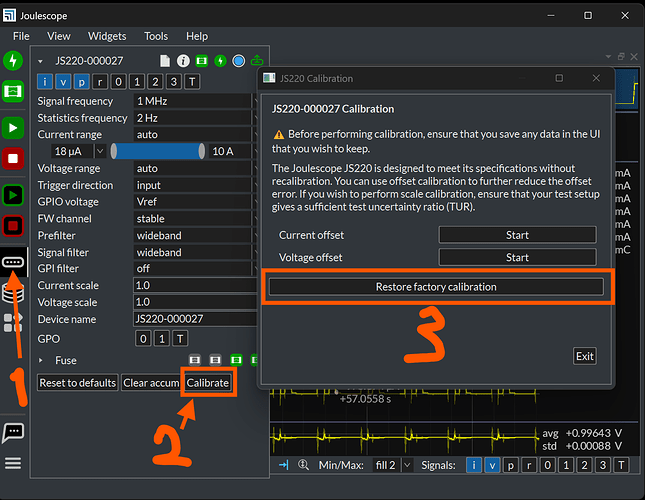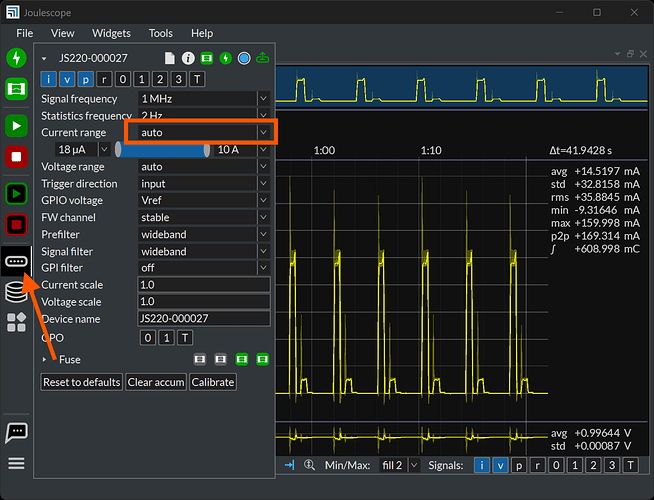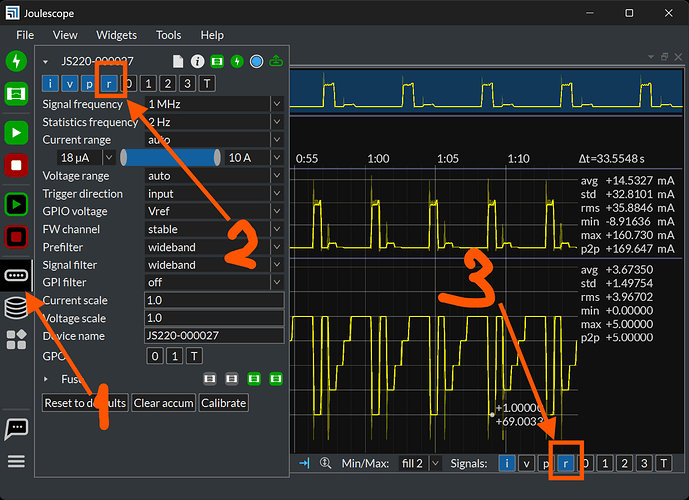We have been using the Joulescope JS220 since and have recently acquired the Keithley DMM6500 to perform more accurate current measurements for our experiments.
In a recent setup, we connected the Keithley DMM6500 and the Joulescope JS220 in series with a target device to measure current consumption on the target device. However, we observed that the JS220 did not report the same current as the DMM6500, which led us to suspect potential calibration differences between the two devices.
To further investigate, we replaced the DMM6500 with the FLUKE 15B+ digital multimeter in the same configuration. However, we found that the current readings from the FLUKE meter also did not align with those from the JS220. The discrepancy between the JS220 and the DMM6500, as well as the JS220 and a FLUKE meter, persisted.
We assume that the difference in readings might be due to calibration variations between the devices. However, we haven’t had the opportunity to validate the readings captured by the Joulescope JS220 previously due to the unavailability of the Keithley DMM6500. Given the significant disparity between the JS220 readings and the DMM6500, we are wondering if there is a possibility that the JS220 might be showing drifted results due to faulty hardware or if the values we see on the JS220 are within the expected tolerance range for this device.
We would greatly appreciate any insights you can provide on whether this discrepancy is due to a hardware issue with the JS220 or if these results are typical for this model. For the reference, we are attaching the results captured on all other devices along with the JS220.

Thank you for your time and assistance. We look forward to your response.
Hi @Victor393 and welcome to the Joulescope forum!
The Joulescope JS220 and Keithly DMM6500 should compare very well, especially for static measurements. We use the even better DMM7510 as part of the JS220 factory calibration.
Dynamic measurements have some added complexity in some setups, both for those multimeters and the JS220.
I have some things for you to try to troubleshoot this issue.
-
Please restore your Joulescope JS220 to the factory calibration. We have had some customers incorrectly perform offset calibration that causes unbounded inaccuracy. Here is how to restore factory calibration:
-
Can you make a static measurement somewhere between 2 to 15 µA? Replace your target device with a suitable resistor. For a 3.3V supply, a 1 MΩ resistor is great. Set the JS220 Current range to auto, like this:
The DMM6500 and JS220 should measure very similar values. Here are the JS220 accuracy specifications:
What do you measure?
-
You have listed a current range for the JS220 in column 5 of your tabel. Did you manually set this range or leave the JS220 in autoranging? If you have set manual ranges, have you ensured that the actual signal never saturates the JS220’s range?
-
Does your target used a switched-mode DC-DC regulator? While many switched-mode regulators work great with JS220’s, others present measurement challenges with the JS220’s much larger signal bandwidth. Without additional setup, the JS220 will measure this real current causing the JS220 to autorange up to the 10A range. The larger inaccuracy of this range then results in more combined measurement error than you may like. To figure out if this is happening, keep the JS220 configured for Current range set to auto. Repeat your original 15 µA measurement with your target device. Enable the Current range input r in both the device and the Waveform widget, like this:
What does the Waveform widget show? Does the Current Range signal r ever leave the 18 µA range? Can you share a screen shot and JLS file?




